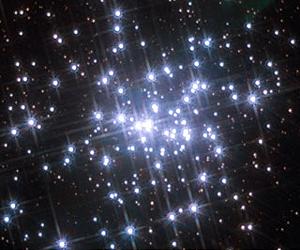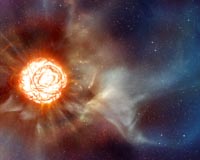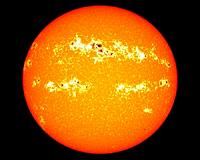|
 Hubble Catches Stars On The Move
Hubble Catches Stars On The MoveHeidelberg, Germany (SPX) Jun 03, 2010 By exploiting the exquisite image quality of the NASA/ESA Hubble Space Telescope and comparing two observations made ten years apart astronomers have, for the first time, managed to measure the tiny motions of several hundred young stars within the central cluster of the star-forming region NGC 3603. The team was surprised to find that the stars are moving in ways that are at odds with the current understanding of how such clusters evolve. The stars in the cluster have not "settled down" as expect ... read more |
. |
|
|
Free Space, Earth, Energy And Military Newsletters - Delivered Daily |
| . | . |
| .. |
Nearby Black Hole Is Feeble And Unpredictable Miami FL (SPX) May 28, 2010
Miami FL (SPX) May 28, 2010For over 10 years, NASA's Chandra X-ray Observatory has repeatedly observed the Andromeda Galaxy for a combined total of nearly one million seconds. This unique data set has given astronomers an unprecedented view of the nearest supermassive black hole outside our own Galaxy. Astronomers think that most galaxies - including the Milky Way - contain giant black holes at their cores that are ... more NASA Spacecraft Burns For Home, Then Comet  Pasadena CA (SPX) May 31, 2010
Pasadena CA (SPX) May 31, 2010NASA's Deep Impact/Epoxi spacecraft has successfully performed a trajectory correction maneuver to refine its orbit prior to an upcoming Earth flyby June 27. The maneuver, along with the Earth flyby, will place the spacecraft on a trajectory to fly past comet Hartley 2 on Nov. 4. The maneuver began at 2 p.m. EST (11 a.m. PST), when the spacecraft fired its engines for 11.3 seconds. While t ... more 'Out Of Whack' Planetary System  Houston TX (SPX) May 28, 2010
Houston TX (SPX) May 28, 2010The discovery of a planetary system "out of whack," where the orbits of two planets are at a steep angle to each other, was reported by a team of astronomers led by Barbara McArthur of The University of Texas at Austin McDonald Observatory. This surprising finding will affect theories of how multi-planet systems evolve and shows that some violent events can happen to disrupt planets' orbit ... more |
.. |
 The Cosmic Burp Of Dying Stars  Why NASA Keeps A Close Eye On Sun's Irradiance  Instant online solar energy quotes Solar Energy Solutions from ABC Solar |
.. |
|
|
Free Space, Earth, Energy And Military Newsletters - Delivered Daily |
|
|
. |
 Bright Galaxies Like To Stick Together
Bright Galaxies Like To Stick TogetherLondon, UK (SPX) May 27, 2010 Astronomers using the European Space Agency's Herschel telescope have discovered that the brightest galaxies tend to be in the busiest parts of the Universe. This crucial piece of information will enable theorists to fix up their theories of galaxy formation. For over a decade, astronomers have been puzzled by some strange, bright galaxies in the distant Universe which appear to be forming stars at phenomenal rates, making them very hard to explain with conventional theories of galaxy formation. O ... read more |
| The contents herein, unless otherwise known to be public domain, are Copyright 1995-2010 - SpaceDaily. AFP and UPI Wire Stories are copyright Agence France-Presse and United Press International. ESA Portal Reports are copyright European Space Agency. All NASA sourced material is public domain. Additional copyrights may apply in whole or part to other bona fide parties. Advertising does not imply endorsement, agreement or approval of any opinions, statements or information provided by SpaceDaily on any web page published or hosted by SpaceDaily. Privacy statement |
| Previous Issues | Jun 03 | Jun 02 | Jun 01 | May 31 | May 28 |